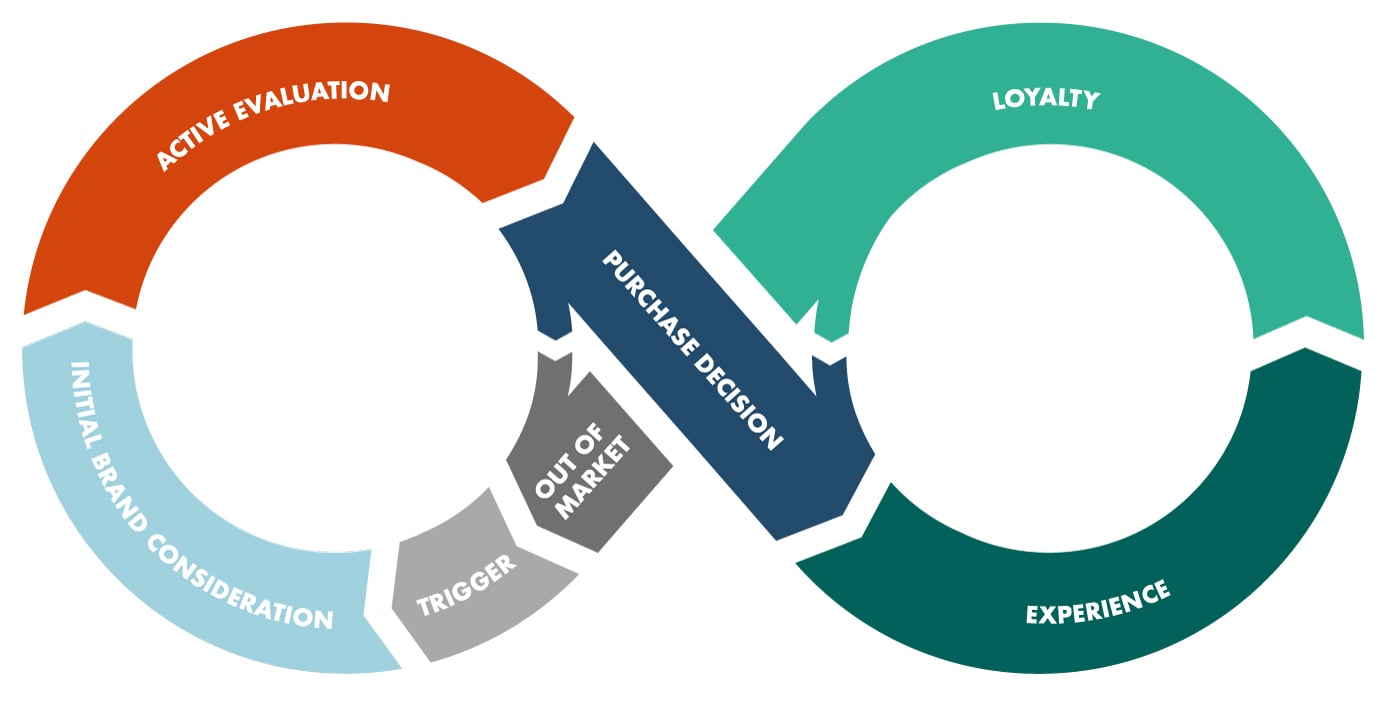From the customer journey to marketing frameworks: How putting the customer first shaped our global marketing strategy
The way businesses grow revenue is very different these days.
Back in the days the salesperson had all the knowledge and, therefore, was in charge of the sale.
Today, the power is in the hands of the customer!
The rapid growth of digital technologies have brought about a multitude of engagement channels, while the endless flow of information have empowered the customer in a whole new way.
According to a study by CSO Insights, more than 70% of B2B buyers fully define their needs before engaging with a sales representative, and almost half identify specific solutions before reaching out.
B2B buyers use approximately 5 different information sources during their buying journey. And it takes on average 6-8 touchpoints for a prospect to become a “sales ready” lead – meaning being ready to enter into a conversation with a sales person.
Now, that’s a long way, isn’t it?
So, does it mean that you need to hire more people and increase costs in order to meet potential customers in as many digital and physical touchpoints with as much information as possible?
Our answer to that would be no.
Instead, we believe that where you should be and what you should do depends upon who your target customer is (vs. just anyone). It’s only by mapping the customer journey can you find the best combination of relevant channels, actions and touchpoints.
And while there are many ways to do this, let us share with you how we did it.
Identifying a misdirected approach
As a CRM company, we have always been very customer-focused. This is why we have always had specific processes in place for how Sales, Consulting and Customer Experience (CX) people should engage and what they should do in order to help our customers in various touchpoints.
The problem was – we didn’t have anything like that for Marketing. And that started to cause problems.
Mistakenly, we thought that since today’s B2B buyers (our potential customers) tend to do a lot of research on their own and look for information on products almost everywhere, we too needed to be everywhere.
Meaning, the more touchpoints that we are present at, the better, right?
Not exactly.
The problem was that we ended up spending too much time on the activities which we thought were the best but weren’t necessarily right for our target customers.
People saw marketing as an email, an ad, an event, a podcast, and a video. Marketing was also Facebook. It was LinkedIn and it was YouTube. We mixed up content types and channels.
The activities that we did were disjointed and weren’t seen as parts of the customer journey. They were only activities unto themselves.
Looking back now, we shouldn’t have focused so much on the variety of touchpoints or what we assumed was interesting for our customers. Rather, we should have been asking ourselves, which touchpoints were the most important for our target customers at each buying stage? And (most importantly) which touchpoints bring the most value to our customers?
Luckily, we realized that what we needed was to step into our target customers’ shoes and think from their perspective, not ours.
To do that, we needed to change the direction of our thinking from inside-out to outside-in.
Inside-out vs. outside-in thinking
Created in the late 1990’s, the customer journey concept is a business management technique meant to help companies create an outside-in strategy, rather than inside-out.
What’s the difference between the two?
Simply put, an inside-out strategy focuses on what the company is good at and/or what they love to do, what they stand for, and why they even exist. It’s about streamlining systems and processes, looking at internal resources and evaluating how to make things better with what you have.
An outside-in strategy focuses on customer needs, customer insights, and customer value. We put ourselves in the shoes of the customer and see things from his/ her viewpoint and work to integrate as much as we can to give them the best customer experience possible.
Getting everyone on board
Although driven by marketing, the customer journey is actually a tool owned by the entire company. It is meant to eliminate silos and help everyone in the company reach the same key goals – find new customers and increase customer loyalty.
The most important element of the customer journey is the Customer Journey Map that defines the touchpoints and channels at different stages of the journey. It also includes what you provide the customer with and what the customer would like to receive from you at different stages. The gap between the two shows the misalignment – a channel or an activity that you haven’t used to your advantage.
We started with customer journey mapping workshops in the central marketing team and then we took the concept “on the road” to the subsidiary countries.
In preparation for the meeting, we sent each local country team some advance material:
- SuperOffice customer target groups and their characteristics
- Key buyer personas and stakeholders that we communicate with
- Current customer journey stages, phases and touchpoints
This advance material explained that the customer journey is drawn from the mindset of the ideal target customer and that they needed to also consider the following issues as part of the workshop:
- Current local market situation and position
- Current customer base
- Current partnerships/ opportunities
- And any other relevant national circumstances
All of this information was taken into consideration when we drew the customer journey map together.
Mapping the customer journey
We kicked off by discussing the customer journey model, which looked like this:

For each phase of the customer journey, we would first outline the objective of the phase and show what the initial customer mindset might be in that particular phase.
Workshop participants were invited to qualify or dis-qualify as well as add or take away a mindset or a behavior.
Here is an example of the Trigger phase:
missing illustration
Using the data that they had gathered, their combined know-how, as well as customer or prospect feedback, each country team would then list in the middle column where they thought customers would go in order to find inspiration or answers to their questions or pains. Representatives from all the functional areas were present.
While we did that, we noticed that it was very easy for us to fall into the inside-out trap. We had to remind ourselves several times during the workshops to think outside-in! So, it was very important to always stay focused on the customer’s mindset.
Once the middle column was filled in, the workshop participants were asked to list the marketing touchpoints that they were currently present at and how much effort they used on each activity.
When the mapping was done, we moved on to the gap analysis.
The gap analysis
As with any other company, we do not have unlimited resources, nor an unlimited budget. Therefore, it was important to make smart decisions on which touchpoints/ channels we should focus on first.
We ranked the select activities and channels on the scale of their perceived impact potential, as well as by the amount of resources each activity would require, as shown below.
missing illustration
In this context, we also needed to keep the following factors in mind:
- Financial framework (budget)
- Local organizational skills and capacity to follow up in a solid way
- Setting priorities and focusing on quick wins, as well as long-term improvement
When we were finished, a sample gap analysis would look something like this:
mising illustration
The gap analysis was one of the most important exercises, as it helped us to:
- pinpoint the activities that we were spending too much time on and with little value to our customers, as well as
- notice those activities that we should focus more on in order to create value for our customers.
Because the customer journey ties the end-to-end customer experience together, we also found areas where we could improve.
For example, we discovered that the onboarding process for our customers could be better and the support offering could be clarified, so that it was easier for our customers to see what kind of help they would get in the Experience and Loyalty phases.
Coming up with a marketing process
During the customer journey workshops, it became obvious that we needed to have a dedicated process for marketing, which would help identify why we were doing what we were doing and in which touchpoint.
This is why we created the marketing process, SMM (SuperOffice Marketing Method), aligning everything we do with the customer journey.
missing illustration
Customer journey as a stimulus for business growth
The customer journey helped us to put things into perspective, especially when it came to Marketing.
For the longest time, we left marketing to chance. And what we learned is that it is just as important of a business process, as all others, because it has a significant impact on the customer experience.
Marketing is not about a specific channel or being in as many touchpoints as possible.
As Peter Drucker said: “The aim of marketing is to know and understand the customer so well, the product or service fits him and sells itself.”
Marketing is about understanding customer needs and then having the vision to be able to deliver on it.
And it starts with one question – “How can I help you?”
Conclusion
Before we did the customer journey workshops and the mapping, we believed that if our customers were everywhere, then we needed to be everywhere too.
Through this process, we’ve realized that the content we produce and how we spread it depends on the mindset of our target customers during different phases of their customer journey.
That is why – the introduction of the customer journey helped us to become more focused on our target customers and their preferred touchpoints at each stage of the buying process.
It also helped us to be much more conscious of outside-in thinking and how we provide value through every interaction. And we do this by trying to understand who our customers are and what they are trying to do, listening to them at all key touchpoints, asking ourselves, “Is this what’s best for the customer?” and then acting on the information that we collect.
Of course, all of this leads to an improved customer experience.
And it is these kinds of business results that we like!
To get more inspirational and best practices content for your business, please visit our Resources section.
